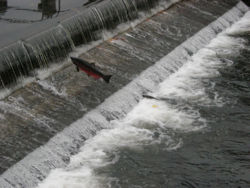Coho salmon
| Coho salmon |
|---|

|
| Scientific Classification |
|
| Binomial Name |
|
Oncorhynchus kisutch |
| Coho salmon swimming upriver |

|
On Day 6 of Creation God created seven species of Pacific salmon that belong to the genus Oncorhynchus. The Coho salmon is one of these seven species. The Coho salmon is one of only five species that are found in California. [1]
Anatomy
The spawning adult Coho salmon usually become around 55-70 cm FL and also weighing around 3-6 kg. They have about 9-12 dorsal fins and about 12-17 anal fins. The Coho also has about 13-16 pectoral fins and between 9-11 pelvic fins. The head and back of spawning adult Cohos are black and dark green. Their sides are maroon to brown. Their belly is gray to black. Females are much more pale than males. The spawning males have a bright red lateral stripe, a hooked jaw, and a humped back. Both male and female have small black spots on their back, their dorsal fin, and the upper lobe of their caudal fin. [2]
Reproduction
The Coho salmon, like any other salmon, reproduces by laying their eggs in the same stream where the first hatched. A female Coho lays an average of 3,000 eggs, of which only about 300-2,700 hatch. From about 3,000 eggs only around 300 hatch and become fry. From the 300 fry, only about 50 live to become smolts, only around 4 of the 50 smolts live to become ocean adults. Only 2 of the ocean adults live to become spawning adults. [3]
Ecology
The Coho's habitat and ecology is similar to that of the Chinook salmon, but also quite different. the Coho prefers a lower stream velocity, they also prefer smaller gravel and shallower water. Coho salmon spend the half of their life cycle in streams and small freshwater rivers. Historically, the Coho salmon was distributed throughout the North Pacific Ocean from California to Alaska. The Coho was also distributed through the Aleutian Islands and from Russia to Japan. The Coho also probably inhabited most of the coastal streams and small rivers in Washington, Oregon, and California. [4]
Other
Salmon species on the west cost of the United States have been experiencing declines in abundance throughout the past several decades as the result of natural and human induced factors. [5]






